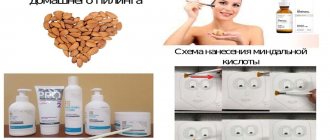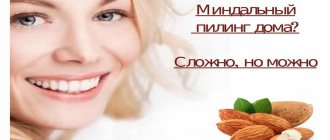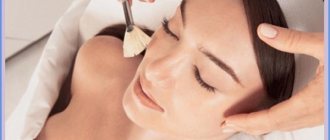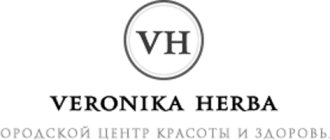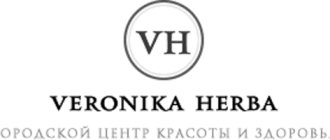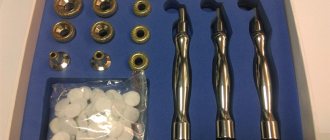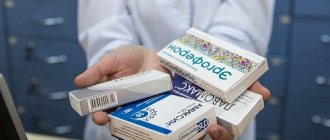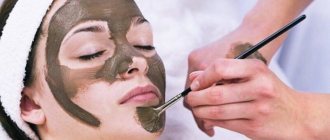The exfoliation procedure is basic in care programs for all skin types. Removing dead cells has a beneficial effect on the processes of renewal, blood flow, and rejuvenation. Superficial cleansing helps to visually refresh the color and increase the elasticity of the skin. Cosmetologists prescribe chemical compositions, selecting formulas to solve individual problems.
Thanks to peeling, you can correct many aesthetic defects and delay aging. Some of the most popular types among both specialists and patients are almond and glycolic. Which peeling is better - almond or glycolic, what are the differences and what results can be achieved, you should know before doing it.
What is almond peeling
It is one of the most gentle types of exfoliation; it can be used during periods of maximum solar activity . The main active ingredient is mandelic acid, obtained from almond kernels.
A type of AHA acids, often included in anti-aging creams and serums. At high concentrations it can cause dryness, skin irritation and even chemical burns. Therefore, the procedure is prescribed by a specialist after assessing the condition of the skin.
Large acid molecules act only on the surface and cannot penetrate into the deeper layers of the skin. During the procedure, it is not possible to block the synthesis of melanin; restoration of tone and whitening occurs due to exfoliation of the epithelium.
Smoothing of superficial wrinkles and improvement of structure is observed due to the removal of keratinized cells.
Important point! The procedure does not affect the synthesis of collagen and elastin, so you should not expect a lifting effect. But slow penetration allows almond peeling to be performed on patients with thin, sensitive skin, as well as those with rosacea.
This is an ideal option for young people with problematic, porous dermis. Thanks to the effect, it is possible to reduce the synthesis of sebium, whiten acne marks, and prevent the development of inflammation. After 30, it is prescribed to enhance the activity of mesotherapy, biorevitalization and other care programs, as well as as preparation for mid-peelings.
Indications for:
- oily skin;
- seborrhea;
- melasma;
- lentigo;
- intolerance to glycolic peels;
- folliculitis;
- unexpressed pigmentation;
- unhealthy tone;
- stressed, dry, irritated skin.
For a lasting, long-term effect, it is necessary to undergo from 5 to 10 sessions, with a frequency of once every 7-10 days. It is often a preparatory step during mechanical or vacuum cleaning to facilitate the removal of sebaceous plugs.
You can use professional products yourself at home, but the result will be less noticeable than when contacting a specialist.
Stages of implementation:
- The face is cleansed of makeup.
- Almond peeling is applied with a brush; even the delicate skin of the eyelids is treated with the solution, right up to the eyelash edge.
- Unlike other types of peelings, a white mask is not formed. The signal for applying a neutralizer is the appearance of slight redness.
- To restore and prevent swelling, use a mask with a complex of antioxidants.
- At the final stage, in addition to pigment-constricting powder, sunscreen is used.
Target areas are face, neck, décolleté, hands. Despite the possibility of carrying out in the summer, it is necessary to follow the rules of post-peeling care:
- for cleansing, use soft, gentle foams;
- when peeling, apply anti-inflammatory moisturizers with hyaluron and aloe;
- You should not use decorative cosmetics for about 5 days, then choose products with a non-comedogenic effect;
- you cannot visit the sauna, swimming pool, solarium, gym;
- Apply sunscreen before going outside.
Which peeling is best for oily skin?
It is a mistake to assume that any superficial peel will do (unfortunately, professionals also make this mistake).
Peeling requirements for oily skin:
- The ability of an acid to dissolve sebum (fat-soluble), otherwise it does not penetrate into the pores. For example, glycolic and lactic acids in the peeling composition are not able to dissolve comedones and penetrate the pores.
- Gentle on the skin. As you know, oily skin reacts to any irritation (the use of alcohols, irritating concentrations of peeling acids, even ultraviolet radiation) by activating the sebaceous glands and increasing sebum production.
What is a glycolic peel?
Exfoliation with glycolic acid is a superficial, gentle type of procedure. Prescribed for the care of different skin types. It has no age restrictions and can be used for patients over 15 years of age.
The glycolic acid molecule differs from almond in its small size and easily penetrates into tissues, promoting deep hydration.
It has antioxidant properties, removes toxins and cellular breakdown products. As a result of application, renewal processes are launched, the network of superficial wrinkles disappears, and collagen activation is activated. Despite the delicate cleansing, glycolic acid is used to solve a whole range of cosmetic problems.
Indications:
- preparation for anti-aging procedures;
- unhealthy, dull color;
- dark spots;
- the first signs of aging;
- thickening of the stratum corneum;
- the appearance of hair ingrown into the skin;
- acne, acne disease;
- loss of elasticity;
- dry, dehydrated skin.
Attention! It is not performed in the spring and summer, as well as for patients with dark skin and dark eyes.
To achieve the desired results, it is necessary to complete a course of 5–10 sessions; the number and frequency are determined by a specialist for each patient individually. Doping preparation consists of using creams and serums with AHA acids to achieve the maximum effect of the procedure. The patient also needs to stop taking alcohol, medications, and limit visits to the gym and solarium pool.
Stages of implementation:
- The specialist cleanses the covers of makeup and other contaminants.
- The integument is treated with a weak solution of glycolic acid, which helps loosen dead cells.
- Afterwards, concentrated glycolic peeling is applied, the exposure time is determined individually due to the appearance of a characteristic white mask.
- To prevent acid from penetrating into the deep layers of the skin, a neutralizer is distributed, blocking the movement of molecules.
- A restorative mask is applied to soothe the skin.
- At the last stage, sunscreen must be used.
The procedure is comfortable, but in some cases there is a burning sensation, which the specialist neutralizes with a stream of cold air.
The post-peeling period is standard; it is necessary to limit sun exposure and use products with a high protection factor. For several days you should limit the use of decorative cosmetics; prohibitions also apply to drinking alcohol, visiting a solarium, sauna, and swimming pool.
What are the differences between peelings?
The main difference is the possibility of using almond exfoliant in patients with intolerance to glycolic acid. Almond can also be used for rosacea, for face and body care. All-season use allows you to maintain a well-groomed blooming appearance throughout the year.
Glycolic has a more pronounced property of moisturizing, restoring elasticity, and reducing the number of superficial wrinkles due to its low molecular weight. Superficial peels have general contraindications, stages of implementation, as well as post-peel care. To achieve the desired aesthetic result, you must undergo a course of procedures. What is better to choose is decided only by a cosmetologist during an individual consultation.
Both almond and glycolic cleanses may cause side effects. They are temporary and, if you follow the rules of the post-peeling period, go away on their own. To prevent unwanted effects, you should choose an experienced, qualified cosmetologist.
Complications:
- redness, swelling;
- peeling, dryness, feeling of tightness;
- irritation, increased sensitivity.
Contraindications:
- pregnancy, lactation;
- herpes in the active stage;
- damage to the integrity of the integument, wounds, burns;
- viral infections;
- the presence of foci of inflammation;
- oncology;
- carrying out a course of treatment with hormonal or antibacterial drugs.
The exfoliation effect of different types of acids is also common. As a result, the skin looks refreshed, renewed, it is possible to cope with superficial wrinkles and remove unexpressed pigmentation. Regeneration processes are normalized and aging is effectively prevented.
Unlike almond and glycolic, salicylic peeling can be superficial or medium. It is used primarily in a program for restoring dense, porous skin, with enlarged pores, sebaceous plugs, and frequent inflammatory elements. In addition to cleansing, it helps regulate sebium production and neutralize the effect of pathogenic microflora.
Just like superficial peels, it requires a course of treatment to achieve the desired effect. This is only part of the program for restoring oily problem skin; consultation with specialized specialists, the use of professional line care products at home, as well as lifestyle and nutrition correction to normalize intracellular processes are required.
Milk peeling is intended exclusively for the care of thin, dry dermis. It has a gentle effect, removes toxins and dead cells, and restores hydrobalance. Unlike other types of exfoliation, the compositions work on the principle of gommage. In some cases, patients note the absence of pellets during the procedure, which is due to the delicate effect of milk peeling on the skin.
Why do facial skin appear oily and enlarged pores?
Enlarged but clean pores
This is a hereditarily determined feature of the skin structure. The reason is oily skin type and excess oil production.
As we age, oily skin loses its elasticity and pores become even more noticeable.
What to do?
At a young age, use astringents with tannins - when applied, they visually tighten the pores, making them less noticeable.
At the start of age-related changes, emphasis is placed on restoring the collagen framework of the skin - the use of anti-aging drugs.
Enlarged pores, “clogged” with comedones (blackheads)
In this case, the pores are overstretched with contents - a mixture of skin secretions and exfoliated skin cells.
Their narrowing can be achieved only by competent selection of daily home care for facial skin in combination with regular professional pore cleansing, including peeling.
What to do?
With the help of a specialist, select home care products aimed at cleansing the skin and regulating sebum production.
Professional care - undergo a course of superficial skin peeling, then perform a maintenance peeling procedure once a month to maintain the result.
Which technique is better?
Only a specialist can give a clear answer as to which type of peeling to prefer. The choice of exfoliant depends on the individual characteristics of the patient, as well as cosmetic goals.
Factors influencing the choice of peeling:
- phototype - almond can be performed on clients with dark skin, dark eyes and hair; the use of glycolic acid can lead to pigmentation;
- seasonality - almond is used throughout the year, naturally, during the recovery period the skin requires protection from sunlight, a contraindication for glycolic is the spring-summer period, it is optimal to take the course from October to March;
- aesthetic tasks - almond is used to solve various dermatological problems associated with hyperpigmentation, impaired secretion of the sebaceous glands, suitable for delicate, thin skin of the eyelid area, glycolic acid is used to restore hydrobalance, due to the properties of penetration into the deep layers of the epidermis;
- peelings are often used to prepare the skin for more complex cosmetic procedures; the choice of composition is influenced by the objectives of the program.
Opinion of cosmetologists
Masters share their experience of working with acid compounds, describe the effect and application features.
The specialist describes the experience of using almond peeling from Slim diets. Indicates the need for careful use on sensitive areas, but after peeling there is a remarkable transformation effect.
The cosmetologist writes that if you have rosacea, you can use almond peeling.
The specialist describes the properties of glycolic peeling, universal use for all skin types except rosacea. After gentle exfoliation, cleaning is carried out, then the rashes are stopped with special preparations. As a result, the effect of rejuvenation, lightening, and moisturizing of the skin is achieved.
Patient reviews
Peels are popular and are carried out not only in the salon . Many users appreciated the effect when using it at home. The result depends on the condition of the skin, the presence of contraindications, as well as the aesthetic problem for which the procedure is performed.
The author writes about the use of professional 10% glycolic peeling at home, good effect and economical consumption.
The user describes the experience of using almond peeling, its advantages and disadvantages.
The participant points out the discrepancy between the price and the effect of almond peeling; the disadvantages of the procedure include the need for a course.
The author writes that when using 10% glycolic acid, no peeling is observed. For a more pronounced effect, she plans to try peels with a higher concentration.
Advantages of the procedure, contraindications
The main advantages of using almond peeling:
- No visible irritation on the skin;
- Versatility - equally effective for any phototype;
- Improving skin condition - cleansing and narrowing pores, eliminating comedones, acne, shallow scars;
- Light lifting effect – stimulates collagen fibers, eliminates fine wrinkles;
- Possibility of use for rosacea - rosacea, almond peeling, of course, does not cure, but intensively moisturizes the skin, tightens it and normalizes oiliness (due to this, the vascular network can decrease);
- Evening out skin tone;
- Antioxidant effect;
- Possibility of use at any time of the year - the procedure can be carried out even in summer on not very hot days - with proper care it will not affect the condition of the skin in any way (one of the few peels that can boast of this).
Important. Almond peeling is safe even for thin and sensitive skin: thanks to its slow and shallow penetration into epithelial cells, the acid has a gentle effect and at the same time perfectly cleanses, tightens, and moisturizes.
Despite its versatility and delicate action, the drug is not suitable for use in a number of cases:
- Bacterial, fungal skin diseases (microsporia, herpes, etc.);
- Purulent acne;
- Mechanical damage;
- Signs of acute respiratory infections;
- Diabetes;
- Psoriasis;
- Dermatitis in the acute stage;
- Fresh tan;
- Oncological and inflammatory diseases;
- Tuberculosis;
- Pregnancy, lactation period.

